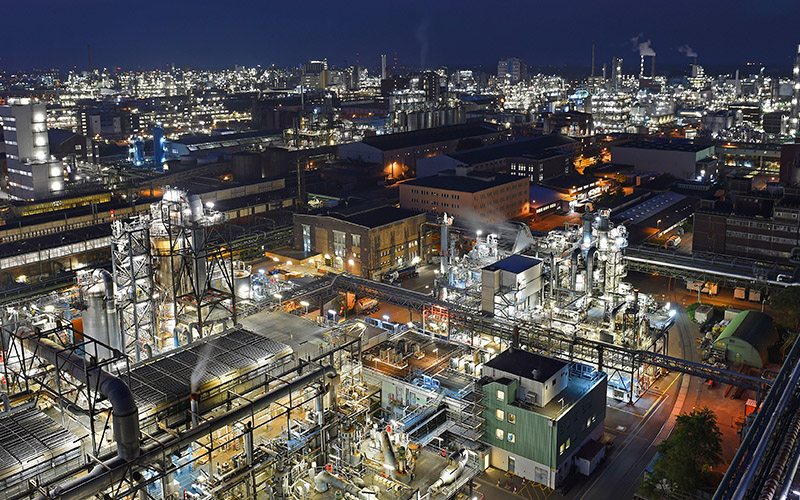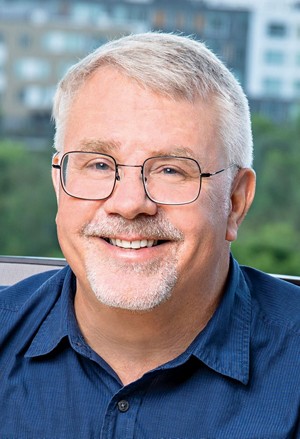By Becky Chambers Hennessy, contributing writer

BASF SE is the world’s largest chemical producer with headquarters at its Ludwigshafen, Germany, complex. The site houses some 200 production plants that serve customers spanning virtually every industry. In February, BASF SE announced plans to reduce absolute CO2 emissions by 25% by 2030. The company’s 2050 target is net zero emissions. Photo credit: BASF SE.
If you haven’t heard the drumbeat from the American Chemical Society (ACS), April 17 marks the start of 2022 Chemists Celebrate Earth Week, designed to promote “the positive role that chemistry plays in the world.” But as important as that role is, let’s face it: “Chemistry” has an image problem.
It’s no wonder. The chemical sector is the world’s biggest user of oil and gas, and with the third-largest carbon footprint behind the metals and cement industries, according to multiple experts such as the International Energy Agency and Intergovernmental Panel on Climate Change. Greenhouse gases are emitted at every lifecycle stage of industrial chemicals, from production to use to waste.
“There also are those who see chemistry as a cause of climate change and environmental damage, and the creator of insidious components in everyday products that may cause diseases,” award-winning chemist, educator and inventor John Warner said. For them, the word “chemical” stirs up negative connotations when, in fact, chemicals play a vital role in everything from vaccines that address global pandemics to computer chips that drive space exploration, added Warner, co-author of the defining text for the field of “green chemistry” (Sidebar 1), which includes the widely cited “12 principles of green chemistry” (Sidebar 2).
| The 12 Principles of Green Chemistry In 1998, John Warner and Paul Anastas published the 12 principles of green chemistry to address a variety of ways to reduce the environmental and health impacts of chemical production, and also indicate research priorities for the development of green chemistry technologies: 1. Prevention. Preventing waste is better than treating or cleaning up waste after it is created. |
Sustainability and industry
Increasingly, R&D professionals are directing their efforts toward chemical solutions for climate protection. For example, a core belief at German multinational chemical company BASF SE is that “sustainability starts in research.” At BASF, a key means of reaching sustainability goals such as CO2-free processes is through its global “Know-How Verbund,” a network of R&D collaborations with companies, universities and research institutions.
Through this, pipeline innovations are possible in areas such as mobility and agriculture, including new coolants for electric cars and precision application technologies for agriculture. In a letter to shareholders in February, BASF CEO Martin Brudermüller reiterated the company’s dedication to such sustainability efforts.
“As the largest chemical company in the world … we are ambitious. This applies especially to the transformation to climate neutrality,” Brudermüller said. “We want to show that this transformation and competitiveness are not mutually exclusive.” As part of that commitment, the company wants to reduce its CO2 emissions worldwide by 25% by 2030. Its 2050 target is net-zero emissions.
BASF is a multi-time recipient of the U.S. Environmental Protection Agency’s (EPA) Green Chemistry Challenge Award, the only award given for chemical technologies that incorporate green chemistry principles into design, manufacture and use. Through 2021, 128 winning technologies in the program have made “billions of pounds of progress,” according to the EPA. This includes 830 million pounds of hazardous chemicals and solvents eliminated each year — enough to fill some 3,800 railroad tank cars, or a train 47 miles long.
Green chemistry and education
The EPA’s challenge is open to industry, trade groups, government agencies and academic institutions. John Warner, one of the founders of the EPA’s original program in 1996, said that while it has helped to raise overall awareness about smarter, greener chemistry, more needs to be done to bring academia into the fold. “BASF and other big companies are places where more innovation is possible,” he said. “Academia in particular has been slower to embrace green chemistry as part of their curriculum. Chemists still are not being taught its principles and tools.”
That’s where organizations such as the ACS and public-awareness campaigns like Chemists Celebrate Earth come in. The event is administered by the ACS Office of Science Outreach, which is part of the ACS Division of Chemical Education. The division also sponsors the Biennial Conference on Chemical Education, which this summer will focus on emerging methods for teaching and learning chemistry. And that’s where John Warner for decades has been focusing his efforts. In 2001, for example, he founded the doctoral program in green chemistry at the University of Massachusetts.
“Industry has been finding success in green chemistry; now we need academia to do the same,” Warner said. “Universities — chemistry departments, in particular — need to do more to build it into their classes and labs so that future generations of chemists can do better at integrating health and environmental concerns into their work.” Toward that end, Warner co-founded Beyond Benign, a nonprofit whose mission is to provide K-12 and university educators with the tools needed to make green chemistry an integral part of chemistry education.
Q&A with John Warner

John Warner, American chemist and pioneer in green chemistry, is committed to creating a sustainable future by changing the way chemistry is learned, researched, and used. Photo credit: Zymergen Inc.
John Warner spoke at the R&D 100 Virtual Conference in 2020 on the topic of “green chemistry, the missing elements.” R&D World caught up with him again to ask about the current state of green chemistry education and more:
RD: How is Beyond Benign helping to bridge the current gaps in green chemistry education?
JW: Beyond Benign is helping the green chemistry education community create necessary change in chemistry education. This is done by supporting educators with the training and resources needed to implement green chemistry in their teaching and practice — from K-12 through graduate school.
In K-12, the focus is on educators. Beyond Benign’s Lead Teacher Program provides professional development for teacher leaders who train peers, develop innovative curriculum and provide professional development. More than 200 K-12 lessons have been developed to date.
The Higher Education Program’s focus is on institutional approaches to green chemistry. Through the Green Chemistry Commitment Program — which currently has 93 signers — college and universities adopt green chemistry student learning objectives, preparing students to address hazards and mitigate impacts at the design stage of a product’s life cycle.
RD: Are chemistry students, including future R&D chemists, being adequately taught to innovate?
JW: Chemistry programs worldwide are doing a great job teaching chemists to elucidate mechanisms and create novel and exciting materials that do amazing things. In no way would I suggest otherwise. But there is a big jump between lab-scale experimentation and large-scale manufacturing.
Sadly, many wonderful creations in academic laboratories never manifest in society. I would suggest that the tools of green chemistry are some of the missing elements that bridge this gap. The less green chemistry applied in early research, the less likely the invention will see the light of day and get into the hands of people who need it.
RD: What role does education play in dispelling misconceptions about both chemistry and green chemistry?
JW: I don’t think people outside of chemistry truly understand how ubiquitous chemistry and chemistry inventors are. That the toothpaste they use was invented by the someone standing beside them at their kid’s soccer game. That a component in their cellphone was invented by someone two rows in front of them at church. That the diabetes drug their father takes was invented by someone they saw at the shopping mall. Chemistry is everywhere. But it goes mostly unseen.
Sadly, society has come to view this invisibility of chemistry as something insidious, like a monster under our beds, lurking, waiting to hurt us. Education must play a role in providing students and society with a balance of the amazing benefits of chemistry, tempered with appropriate discussion of potential unintended consequences. Green chemistry, in my opinion, is a perfect vehicle to acknowledge past problems while providing a positive message illustrating a path to a sustainable future.
| What is green chemistry? Green chemistry takes a revolutionary approach to reducing or eliminating the use and generation of hazardous substances in the design phase of materials development. It requires an inventive and interdisciplinary view of material and product design. It follows the principle that it is better to consider waste prevention options during the design and development phase than to dispose or treat waste after a process or material has been developed. For a technology to be considered green chemistry, it must: • Be more environmentally benign than existing alternatives. From Warner Babcock Institute for Green Chemistry, co-founded by John Warner and Jim Babcock. |
RD: What are the key differences between green chemistry and sustainable chemistry?
JW: For green chemistry to be successful, it must create a product with superior performance and appropriate cost. If the technology doesn’t really work, or is too expensive, no one is going to use it. If you want to make a technology more sustainable, you use green chemistry to do so. If you want to make a product more circular, you use green chemistry to do so. If you want to make a product less toxic, you use green chemistry to do so. If you want to make a product contribute less to climate change, you use green chemistry to do so. If you want to make a product less persistent in the environment, you use green chemistry to do so.
Whatever sustainability protocol you choose, circular economy, UN SDGs, Safe and Sustainable by design, the process of inventing the new technology that achieves better performance against that protocol is green chemistry. If a scientist doesn’t have the skills of green chemistry, it is difficult to efficiently address these things. Green chemistry is the mechanistic science underpinning sustainability. While you can measure and describe sustainability in many different ways, the only way to improve the sustainability of a product is through green chemistry.
RD: Are green chemistry and business growth compatible — and, if so, how?
JW: Absolutely. Companies are constantly paying large sums of money to comply with various local, national, and international regulations. The cost of storage, containment, liabilities, training, disposal, treatment, emissions, etc., can be quite significant. All of these costs are directed to mitigating exposure of the potentially harmful material. If one applies the principles of green chemistry to invent a new technology that is intrinsically less harmful, all of these costs are reduced.
Also, there are new and emerging regulations and NGO pressures that will continue to increase in the future. If an organization wants to remain competitive, they have no choice but to adapt 21st-century chemistry — green chemistry.
RD: How can the green chemistry principle about waste prevention be better taken into consideration in R&D?
JW: When chemists learn chemistry, they have textbooks and classes called “organic chemistry,” “inorganic chemistry,” “analytical chemistry,” “physical chemistry,” “quantum chemistry” and so on. We certainly have a full curriculum. But do we have a place where we put concepts of safety, toxicity, environmental harm and sustainability? If a chemist wants to make a dye that is red, they can point to different classes that gave them the basic principles of color, resonance, and synthesis. If they want it to be in a coating that will stick to a surface, they can point to classes that taught them about hydrogen-bonding, van der Waals interactions, and polymers.
But if a chemist is asked to make a molecule that is nontoxic, environmentally benign, or sustainable, if they can’t refer to parts of their education that prepared them to address these issues, how can they succeed? If they understand green chemistry principles, they can add them to their toolbox and can make better products.
RD: What advice do you have for both chemistry students and professional R&D chemists when it comes to green chemistry?
JW: Please think carefully about what you do. When you first write out a chemical reaction you plan to run, when you reach for the reagent that you are about to use, as you design the purification sequence, when you design your analytical processes, please realize that the decisions you make can have profound impact on the future.
If what you do goes into a journal that is only read a couple times, maybe it doesn’t matter so much what reagents and processes you use. But imagine if what you do is really useful. Imagine if other people build from what you do to design products, manufacture them and put them in the hands of hundreds of thousands of people. Their safety, and the safety of their homes, their family and their communities might be touched by your choices.
Take time to learn a little more about green chemistry. You will never look back and regret doing green chemistry, but you might regret not having done green chemistry. The world needs the field of chemistry to take green chemistry seriously.
John Warner, www.johnwarner.org, is an American chemist. He co-founder with Amy Cannon of Beyond Benign, where he is helping to design and disseminate green chemistry and sustainable science educational resources. In 1998, Warner and Paul Anastas co-authored the defining book on green chemistry, which includes the widely cited practice guide, the 12 Principles of Green Chemistry. Warner is a SVP of chemistry and distinguished research fellow at Zymergen Inc., where he helps create commercial technologies inspired by nature consistent with green chemistry principles. With more than 300 patents, he has invented solutions that have served as the basis for several new companies. He is co-founder with Jim Babcock of the Warner Babcock Institute for Green Chemistry, and is the recipient of the 2014 Perkin Medal, the highest honor in American industrial chemistry.




My name is William Johnson I am a developer of green technologies and currently have over 200 issued patents in my name. I love this article but it seems that companies are not interested in going green but they are interested in making the public statement that they are looking for solutions. Just one of the technologies I have developed globally changes thermoplastics process ability allowing the companies to say 10% to 20% in energy while increasing their throughput proportionally. I am the co-owner of Ecopuro and I would love to talk to the directors of some of these companies that are truly implementing these new technology.
Take for instance BASF it is such a large company that the question is where do you start?
Their goal is to reduce 25% of their own carbon emissions in the near future, what if they focused on reducing the global carbon emission by 10% to 20% on 80% of the thermoplastics market while simultaneously increasing the productivity of the companies. if you have a contact that I should speak with at BASF, I would greatly appreciate a starting point we have this technology!
God’s blessings!!!
Sincerely will Johnson
William Johnson, thank you for your thoughtful comments on the article, including your address of the topic of global carbon emission reduction initiatives. If you haven’t already, you might contact green chemist John Warner, also a patent holder, at http://www.johnwarner.org. He likely could provide suggestions. Best wishes!